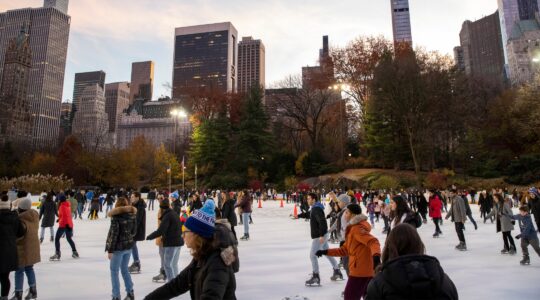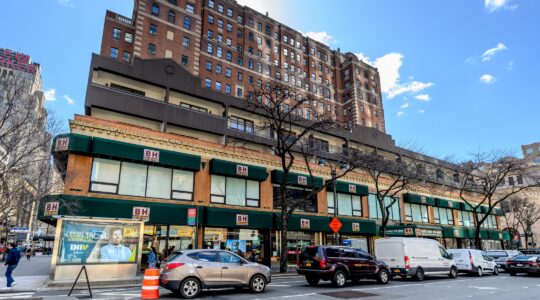‘When you conclude there are no words to express a community’s feelings, then maybe you are thinking in the wrong language.” David Shribman, the editor of the Pittsburgh Post Gazette, wrote this to describe why the banner headline of the Nov. 2, 2018 paper needed to be not in its customary English, but in Aramaic, the language of the Mourner’s Kaddish that Jews recite over the dead.
The Pulitzer Prize-winning religion reporter for the paper, Peter Smith, reminded me of this notion last Thursday as we stood in front of the newly unveiled windscreens at Tree of Life synagogue in the Squirrel Hill neighborhood here. The art exhibit — “#HeartsTogether: The Art of Rebuilding” — which teenagers worldwide contributed to, is part of an attempt to make the exterior of the building, where 11 Jews were killed on Oct. 27, 2018 in the worst act of anti-Semitic violence ever on American soil, reflect the whole of its history; the joyous and celebratory years, filled with optimism and hope and community, not just the horrific massacre inside its walls for which it is now known. Art, and the art created by children, was chosen as the language to express what comes less naturally to adults: hope, optimism, uplift.
The notion that words are insufficient is the best way to grapple with the unfathomable — kind people slaughtered by cruel ones. The deed will never make sense, in words or in visual representations.
Last week, too, was significant, in terms of memory, as the anniversary of 9/11 and the Torah reading that contains Deuteronomy 25:17-19 — the paradoxical injunction both to “remember” and “not to forget” what Amalek did to the Israelites when they were leaving Egypt.
The placement of uplifting artwork by children is part of the “remembering.” Noted University of Massachusetts Jewish studies Professor James Young, who chaired the 9/11 Memorial Commission, speaks of the need to take time in creating a memorial to figure out an event’s significance and what is actually being memorialized. In a meeting with Eric Lidji, the director of the Jewish archive here at the Heinz History Center, Young emphasized that the fullness of time allows the understanding of an event, and that it is a mistake to create a memorial too early.
But as Stephen Cohen, one of the co-presidents of New Light Congregation (which met at Tree of Life), said at the press conference last week, “In a sense the building is a memorial. If you recall last October, the streets were filled with people who came here and left something of their heart behind” at poignant makeshift shrines to the victims.
This exhibit, according to Laurie Zittrain Eisenberg, a history professor at Carnegie Mellon University here as well as third-generation member of Tree of Life and current board member, was based on the offerings of all types left at the site in the days and weeks after the shooting. She wrote in March, “Commemorating death, the memorial was alive, growing larger with each day’s contributions of flowers, messages and artifacts. People from all walks of life arrived at all hours of the day and night, rain or shine. It was alternatively a place of quiet reverence and tears, and a site of much activity and sound.” She concluded that these “artifacts” would help scholars analyze the event.
But before that historical analysis is complete, the teens’ artwork ringing the synagogue tells a powerful story. In one drawing, set against a bright yellow background, four arms, representing different skin tones, interlock, with a heart and a peace sign inside. In another, three children in T-shirts bearing a Jewish star, a Christian cross and a Muslim crescent hold hands at the base of a wide tree trunk, red hearts hanging from its branches. In one of the starkest images, a single, leafless tree stands in a field, its branches arcing up and curling to form the shape of a heart; along the branches are written the names of the 11 worshippers killed at Tree of Life.
Though there is color and cheer and uplift in the drawings, the exhibit asked teens to reflect only on the themes of “unity, strength, gratitude, kindness, diversity and faith”; the rules disallowed the use of the words “hate” or “hatred.” In this way, perhaps, the opportunity to grapple with the reality of evil — and the “don’t forget” part of the biblical injunction — was missed.
And yet, as Eisenberg told the Jewish Chronicle of Pittsburgh in April as the call to artists was underway, by beautifying the building’s exterior with children’s art, the synagogue is “not letting the perpetrator control our mission.” And the sense of hope conveyed in the drawings, curated from entries by children from New Zealand, Columbine, Newtown and Parkland, moved Eisenberg. “The fact that they could envision hope and light after what they went through gives us hope as well,” she said at the press conference.
Passersby have told me that they find the works “authentic.” One driver stopped her car to report, “The art is beautiful.”
As people gather to discuss the art and view it, perhaps they will reconcile the distance between remembering and not forgetting, between beautification and confronting hatred. But with those colorful and poignant drawings hung on tarps on a gritty chain-link fence around Tree of Life, at least we have started to find a language for the discussion to come.
The New York Jewish Week brings you the stories behind the headlines, keeping you connected to Jewish life in New York. Help sustain the reporting you trust by donating today.




